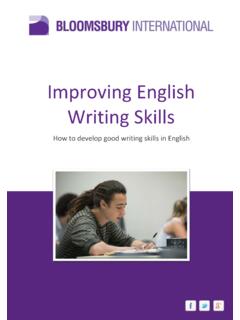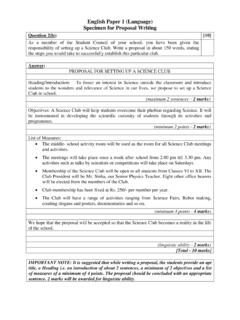Transcription of GCSE (9-1) English Language - Edexcel
1 GCSE (9-1). English Language EXEMPLARS. Paper 1: Fiction and Imaginative Writing GCSE Language 2015. Student exemplar responses for Paper 1: Fiction and Imaginative Writing Contents Introduction 2. Paper 1: Section A - Reading 3. Question 1 3. Question 2 4. Question 3 6. Question 4 10. Paper 1: Section B Imaginative Writing 17. Question 5 17. Question 6 24. Pearson Education Limited 2015. Introduction This pack has been produced to support GCSE English Language teachers delivering the new GCSE English Language course in 2015 (first certification summer 2017). The pack contains exemplar student responses to GCSE English Language Paper 1 (Section A 19th Century Fiction Reading and Section B Imaginative Writing). It shows real student responses to the questions taken from the sample assessment materials.
2 In some cases, the original student responses have been adapted by the marker to provide clearer exemplification of the mark scheme. There are also exemplars for GCSE English Language Paper 2 and GCSE English Literature available to download from our website. Section A questions address three Reading Assessment Objectives: AO1, AO2. and AO4. Reading 50%. AO1 Identify and interpret explicit and implicit information and ideas Select and synthesise evidence from different texts AO2 Explain, comment on and analyse how writers use Language and structure to achieve effects and influence readers, using relevant subject terminology to support their views AO4 Evaluate texts critically and support this with appropriate textual references Section B questions address two writing Assessment Objectives: AO5 and AO6.
3 Writing 50%. AO5 Communicate clearly, effectively and imaginatively, selecting and adapting tone, style and register for different forms, purposes and audiences. Organise information and ideas, using structural and grammatical features to support coherence and cohesion of texts AO6 Candidates must use a range of vocabulary and sentence structures for clarity, purpose and effect, with accurate spelling and punctuation 2. Paper 1: Section A - Reading Question 1. Candidate A. A tub had caught all Marker comment and mark The exact answer has been given. 1 mark Candidate B. A tub had caught all - ha! ha! Marker comment and mark This candidate has achieved a mark as the exact wording is clear although an additional bit has been added. 1 mark Candidate C. I had been too wary for that. A tub had caught all.
4 Marker comment and mark Although the correct phrase has been given, there are two phrases and the question asks to 'identify the phrase'. The particular phrase is not identified here. 0 marks Mark scheme Question (AO1) Answer Mark Number 1 Accept only the following: (1). A tub had caught all'. 3. Question 2. Candidate A. 1. I smiled, for what had I to fear 2. Wild audacity of my perfect triumph Marker comment and mark This candidate gives two quotations to answer the question which is acceptable. 2 marks Candidate B. 1. Covered up the evidence by placing a chair on top of the corpse 2. He was confident. Not insecure. Marker comment and mark This answer achieves one mark for the first point but the second is not specific enough to achieve a mark. 1 mark Candidate C. 1. He smiled and welcomed the gentlemen into his home.
5 2. He showed the men around and sat down with them. Marker comment and mark This candidate has used their own words to answer the question which is acceptable. The first answer could be credited as two points (smiled and welcomed). 2 marks 4. Mark scheme Question (AO1) Answer Mark Number 2 Accept any reasonable answer based on lines 12 to 18, up to a (2). maximum of 2 marks. Quotations and candidate's own words are acceptable. For example: he asks what he has to fear as if the answer is nothing'. he smiles he welcomes the policemen in he is able to make up an excuse for the noise he shows them the whole house he encourages them to search well'/wherever they want he shows them the old man's room/things his Language describes his confidence enthusiasm in my confidence'/ my perfect triumph'. he knowingly puts his seat above the corpse saying that the old man was absent from the country' shows he is able to make up an excuse 5.
6 Question 3. Candidate A. The writer uses Language and structure to show the change in mood by at first he was saying that his manners had convinced them, this suggests that he knew what he was doing and that he was very confident with himself, but as the writer goes on he becomes more agitated by saying 'I talked more freely to get rid of the feeling: but it continued and gained definiteness' by saying this the writer is implying that the narrator cannot contain what he has done and that he is getting very anxious because he knows that the police officers will find out about the dead body. By the end of the paragraph the writer says 'I found that the noise was not within my ears' this is saying that the police are now talking about what has happened and he has realised that it was never in his head.
7 Marker comment and mark This answer offers description of what the narrator is doing - saying his manners had convinced them, he knows what he is doing etc. There is one example of a phrase used to suggest agitation, but it is not specific. There is some basic comment on effect (the implication), but the answer is descriptive. There is no comment on structure so the response cannot move past Level 1. Reward is given for the comment that starts with the idea that the police were convinced by the narrator's manner but that he becomes more agitated. The answer is awarded one mark since it does not look at Language techniques. Level 1 1 mark Candidate B. The writer shows that the narrator's mood changes in this paragraph of the text. He does this by making many pauses in one big paragraph. For example, 'but it continued and gained definiteness - until, at length, I found that the noise was not within my ears'.
8 I believe what the writer was trying to achieve here was a sense of panic, fear and almost traumatisation. This gives a great effect on the reader. Also the writer has used a lot of short words. This could link in with his feelings, because one minute he's fine, then quickly in such a short space of time everything changes. This will make the reader intrigued in what's 6. going to happen next. What makes it more intense for the reader is that they know what the narrator has done, yet the police don't. Marker comment and mark This answer offers very general comment on structure with the reference to pauses, and this has some explanation - to create a sense of panic. However, the response does not consider specific Language features (there is a reference to short words but this has no reference to support it) so therefore cannot progress past Level 1.
9 The comments are not sufficiently explained or referenced to achieve the top of Level 1. Level 1 1 mark Candidate C. To show the narrator's mood change the writer he uses a few sentences at the beginning of the paragraph that show confidence in his mood, for example 'I was singularly at ease'. Then in the sentences are changed to a discomforting mood. He does this by using 'But' as a new sentence opener, and then describes the narrator's physical appearance changing 'I felt myself getting ' He also uses colons a lot throughout the paragraph, to link back to what the police officers are doing to connect the sentences rather than using commas. For example it reads ':But still they sat and still chatted'. Then near the end it says 'The ringing became more and more distinct: it ' I think this gives the feeling of panic, the way he links the sentences.
10 Marker comment and mark This answer offers comment on both Language and structure, but is too brief to move higher than the lower end of Level 2. The Language points, the use of 'But', and the physical description of the narrator and are explained at a basic level as showing discomfort. There is slightly more detail in the comment on structure in the use of colons and this point has valid reference and some explanation - to create rising panic/to create a sense of change. The comments are brief but are sufficiently explained to achieve the bottom of Level 2. Level 2 3 marks 7. Candidate D. At the beginning of the paragraph the narrator is confident - 'I. was singularly at ease'. Allan Poe uses short sentences in the piece at the start and middle to convey the narrator's confidence in the circumstances.











